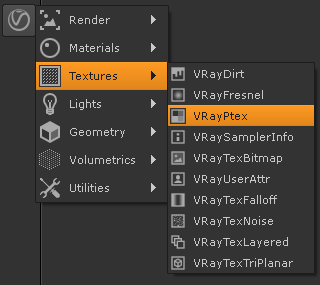This page provides information on the VRayPtex node.
Overview
VRayPtex node gives access to PTex textures within V-Ray. PTex is a mapping system that applies a separate texture to each face of a subdivision or polygon mesh and therefore requires no UV assignment. A PTex file can store an arbitrary number of textures along with mipmaps and adjacency data used for filtering across face boundaries. For more information on the PTex concept, see the Notes section below.
UI Path: ||Toolbar|| > V-Ray menu icon > Textures > VRayPtex
Parameters
Ptex File Name – Specifies the .ptex file that is going to be used as a texture.
Use Image Sequence – Animates the texture per frame if it's a series of images.
Image Number – The frame number of the image to load. This attribute can be animated.
Image Offset – A static offset to the image sequence.
Cache Size (MB) – The information in a PTex file is compressed for storage. In order to be used it has to be uncompressed and stored in the RAM. This parameter controls how much memory (in MB) is available for the current texture. If the value is large enough for the whole texture the information is extracted only once and is stored during the entire rendering. Otherwise the information is constantly read from the hard drive, extracted and used when necessary. Low value for this parameter may cause large PTex files to render slowly.
Filter Type – Specifies the type of filtering that is going to be applied to the texture.
Width – The size of the filter from one side to another.
Blur – Specifies the amount of the blurring.
Sharpness – Available when the Filter Type is set to Bicubic and controls the amount of sharpening applied by the filter.
Interpolation between mipmap levels – A ptex texture may have several mipmap levels which are basically versions of the texture at different resolutions. This allows a higher resolution texture to be applied to parts of the object closer to the camera and a lower resolution version to be applied to parts of the object that are far away. When this option is enabled V-Ray will interpolate between different mipmap levels to create a smooth seamless texture in the end.
Reverse vertex order – A ptex is generated for a specific mesh. Sometimes the program generating the ptex numbers the vertices of the mesh in the reverse order. When this happens the object is not properly textured and enabling this option fixes the issue.
Red/Green/Blue Channel – Manually specify the channel numbers for Red Green and Blue.
Alpha – Specifies the mode in which alpha is applied.
Solid – All alpha information is ignored.
Alpha from texture – The information for the alpha is taken from the specified Alpha channel in the texture.
Alpha from luminance – The alpha information is taken from the Luminance of the RGB channels.
Automatically select color channels – A ptex may have an arbitrary number of channels and there is no sure way to determine which channel contains which information. When this option is enabled V-Ray tries to select the correct channel for Red Blue and Green. When this option is off the user manually specifies which channel contains which information.
Automatically select alpha channel – When on V-Ray automatically selects the alpha channel from the ptex file.
Alpha Channel – Manually specify which channel from the ptex is the alpha channel.
Color Gain – Color corrects the PTex by multiplying the RGB color values in the texture with the RGB color values specified here.
Color Offset – Color corrects the PTex by adding the the RGB color values specified here to the RGB color values in the texture.
Color Space – Sets the lookup table (LUT) used to convert from this file to the internal values used by Nuke.
Linear – Uses linear 32 bit colorspace.
Gamma corrected – Uses the value from the Gamma slider.
sRGB – Uses non-linear sRGB 8 bit colorspace.
Gamma – Sets the gamma multiplier for the node.
Notes
More information about PTex is available here: http://www.disneyanimation.com/library/ptex/
- PTex files are strongly connected to the topology of an objects's mesh. Therefore any modification which change the topology will break the rendering of the PTex texture. If you want to smooth the object, you can use V-Rays own subdivision/displacement.
- When using PTex textures for displacement, small cracks might appear along polygon edges because of slightly different filtering applied to the PTex texture on adjacent polygons. Setting the filter width to 0.0 will improve the situation, but will cause the most detailed mip-map level of the PTex file to be loaded thus increasing the required memory.
- When using PTex textures for displacement, it might be necessary to adjust the Min/M ax parameters of the Displacement Control, especially if the texture has negative colors. Otherwise the texture values might be clipped away.


